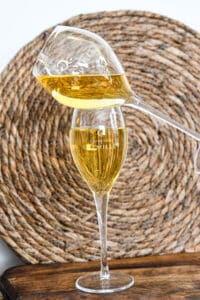
COMPOSITION OF CHAMPAGNE – OENOLOGICAL PARTICULARITIES
When discussing the composition of Champagne, one inevitably thinks of the three grape varieties that account for 99% of production: Pinot Noir, Meunier, and Chardonnay.
When you think of Champagne, cheese might not be the first thing that comes to mind. Yet, the combination of these two flavors can be magical! Gremillet invites you to a Champagne and Cheese tango!
SUMMARY

Champagne and cheese, not just for the rhyme.
Champagne, the quintessential drink for celebrations, is most often associated with aperitifs or desserts. But what if we changed things up a bit by pairing it with another national specialty—cheese? Of course, you’ll need to carefully select the right cheeses, and we don’t have to look far to find the perfect match: Chaource, made in the Aube region, is light in its aromas and thus doesn’t overshadow the finesse of Champagne. Its lactic and salty notes remind us of the Kimmeridgian geological origins of our terroirs… But Chaource isn’t the only one; as we explore different cuvées, we’ll discover other perfectly successful pairings, which are local to boot.
A white-on-white pairing of cheese and champagne
Alright, we all agree to leave the Banyuls, Maury, and Mas Amiel to handle the wedding with the Blues and the Veined cheeses… But we invite you to savor a Champagne Blanc de Noirs and seek a bride in the form of well-aged Époisses—hush, their honeymoon would make you dream… We would continue the journey with a Blanc de Blancs. Here, one mustn’t make a mistake, so we’d head close to home again, to the sources of the Seine, to find it in this beautiful cold country, a plateau—Langres! The winter there is harsh, but summer is very hot, which gives rise to a vegetation that blends the two. So, the milk from the cows has a taste of hazelnuts and wild strawberries… yes, it’s true! With this milk, they make a cheese, Langres, which they dress in Red, like a Coquette… and it presents itself to you in all its beauty.
A colorful pairing of cheese and champagne
The Rosés will also join the celebration! Whether from blending or maceration, both will be equally valid. Here, the cheese dresses up, puts on a hat with fruits and flowers, a fresh cheese, why not a Chaource, embellished with red fruit coulis, strawberry, raspberry, blackberry… Oh, I almost forgot about the Coteaux Champenois, 100% Pinot Noir. It’s a bit like the little cousin, living in the shadow of its elders, the Champagnes, but it sings out loud; pair it with some meat, charcuterie for a rustic meal, a snack with the sound of a hunting horn in the woods… not everything has to be paired with our local cheeses! We also have excellent meats and charcuterie.
Serving temperature of Champagne when paired with cheese
One last tip before leaving you to enjoy this reasoned pairing. It is important not to serve the champagne as cold as usual. At 8 to 10 degrees Celsius, it will be ready for the party, while if served colder, it will pair less well with the cheese, which is served at room temperature. With these two symbols of our country, there’s no doubt that your meal will be a success and the atmosphere lively. Just for this discovery alone, the conversations will be as lively as the bubbles in the Champagne! Maison Gremillet now hopes that this culinary experience will be a success. During your visit with us, we’d be happy to discuss it with you! How about discussing it in the shade of the cadole at Clos Rocher?

When discussing the composition of Champagne, one inevitably thinks of the three grape varieties that account for 99% of production: Pinot Noir, Meunier, and Chardonnay.

For many decades, the production of Champagne has followed a precise and well-established process. The making of Champagne respects traditions and practices, which Maison Gremillet

Understanding the Difference Between Non-Vintage Brut Champagne and Vintage Champagne. The world of Champagne is vast and varied, offering a multitude of choices for wine